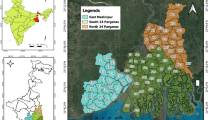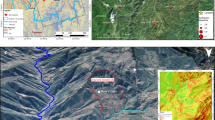Abstract
Understanding the hydrologic patterns in vast wetland ecosystems has proven to be a difficult task. Most of the world’s wetland ecosystems are not adequately monitored for water level, flow, or discharge, and where these are monitored, gauges are usually located on the largest rivers or lakes and canals rather than in the seasonally flooded areas. Even those wetlands that have the most extensive networks of gauges are not sufficiently covered to understand the finer-scale spatial dynamics of hydrologic condition. However, high-density in situ monitoring of stage, flow, and discharge of vast wetland complexes would be prohibitively expensive, even in a region such as south Florida, USA where considerable resources are devoted to water management. Several techniques are presented that were developed to use Synthetic Aperture Radar (SAR) satellite imagery to remotely detect, monitor, and map regional scale spatial and temporal changes in wetland hydrology. This study shows that SAR imagery can be used to create inundation maps of relative soil moisture and flooding in non-woody wetlands. A comparison of in situ water-level data collected from 1997 to 1999 at 12 test sites to SAR imagery revealed that relative backscatter within a site does vary in a linear fashion with changes in water levels. Using SAR imagery collected between 1997 and 1999, inundation maps were created at approximately bi-monthly periods for the south Florida region. This time series of inundation/soil moisture maps (1997–1999) reveals the spatial and temporal variation in degree of flooding in the Greater Everglades, which is information previously unavailable from ground-based observations alone. In addition, hydroperiod maps were created based on a temporal series of 14 months of SAR imagery.
Similar content being viewed by others
Literature Cited
Bourgeau-Chavez, L. L., E. S. Kasischke, and K. B. Smith. 1996. Using satellite radar imagery to monitor flood conditions in wetland ecosystems of southern Florida. Proceedings of the European Symposium on Satellite Remote Sensing III, 23–26 Sept 1996, Taormina, Italy.
Bourgeau-Chavez, L. L., E. S. Kasischke, S. M. Brunzell, J. P. Mudd, K. B. Smith, and A. L. Frick. 2000. Analysis of spaceborne SAR data for wetland mapping and flood monitoring in Virginia riparian ecosystems. International Journal of Remote Sensing 22: 3665–3687.
Coe, M. T. 2000. Modeling terrestrial hydrologic systems at the continental scale: testing the accuracy of an atmospheric GCM. Journal of Climate 13:686–704.
Davis, S. M., L. H. Gunderson, W. A. Park, J. R. Richardson, and J. E. Mattson. 1994. Landscape dimension, composition, and function in a changing Everglades ecosystem. p. 419–444. In S. M. Davis and J. C. Ogden (eds.) Everglades, the Ecosystem and Its Restoration. St. Lucie Press, Delray Beach, FL, USA.
Duever, M. J., J. F. Meeder, L. C. Meeder, and J. M. McCollom. 1994. The climate of south Florida and its role in shaping the Everglades ecosystem. p. 225–248. In S. M. Davis and J. C., Ogden (eds.) Everglades, the Ecosystem and Its Restoration. St. Lucie Press, Delray Beach, FL, USA
Fennema, R. J., C. J. Neidrauer, R. A. Johnson, T. K. MacVicar, and W. A. Perkins. 1994. A computer model to simulate natural Everglades hydrology. Chapter 10 In S. M. Davis and J. C. Ogden (eds.) Everglades: the Ecosystem and Its Restoration. St. Lucie Press, Delray Beach, FL, USA.
Henebry, G. M. 1997. Advantages of principal components analysis for land cover segmentation from SAR image series. p. 175–178. In Proceedings of Third ERS Symposium on space at the service of our environment, SP-414, ESA, Noordwijk, The Netherlands.
Hess, L. L., J. M. Melack, S. Filoso, and Y. Wang. 1995. Delineation of inundated area and vegetation along the Amazon floodplain with SIR-C synthetic aperture radar. IEEE Transactions on Geoscience and. Remote Sensing 33:896–904.
Hess, L. L., J. M. Melack, and D. S. Simonett. 1990. Radar detection of flooding beneath the forest canopy: a review. International Journal of Remote Sensing 11:1313–1325.
Jensen, J. R. 1996. Principal component analysis. p. 172–179. In K. C. Clarke (ed.) Introductory Digital Image Processing; a Remote Sensing Perspective, second edition. Prentice-Hall Inc. Simon & Schuster/A Viacom Company, Upper Saddle River, NJ, USA.
Kasischke, E. S., K. B. Smith, L. L. Bourgeau-Chavez, E. A. Romanowicz, and S. Brunzell. 2003. Effects of Seasonal Hydrologic Patterns in South Florida Wetlands on Radar Backscatter Measured from ERS-2 SAR Imagery. Remote Sensing of Environment 88:423–441.
Kasischke, E. S. and L. L. Bourgeau-Chavez. 1997. Monitoring south Florida wetlands using ERS-1 SAR imagery. Photogrammetric Engineering & Remote Sensing 63:281–291.
Kasischke, E. S., L. L. Bourgeau-Chavez, and K. B. Smith. 1997. Monitoring hydropatterns in South Florida ecosystems using ERS SAR data. p. 71–76. In Proceedings of the 3rd ERS Symposium, 17–21 March 1997, Florence, Italy.
LeToan, T., F. Ribbes, L. F. Wang, N. Floury, K. H. Ding, J. A. Kong, M. Fujita, and T. Kurosu. 1997. Rice crop mapping and monitoring using ERS-1 data based on experiment and modeling results. IEEE Transactions on Geoscience and Remote Sensing 35: 41–56.
Lodge, T. E. 1994. The Everglades Handbook: Understanding the Ecosystem. St. Lucie Press. Del Ray Beach, FL, USA.
Pope, K. O., E. Rejmankova, J. F. Paris, and R. Woodruff. 1997. Detecting seasonal flooding cycles in marshes of the Yucatan Peninsula with SIR-C polarimetric radar imagery. Remote Sensing of Environment 59:157–166.
Pope, K. O., J. M. Rey-Benayas and J. F. Paris. 1994. Radar remote sensing of forest and wetland ecosystems in the Central American tropics. Remote Sensing of Environment 48:205–219.
Sahagian, D. and J. M. Melack, (eds.). 1996. Global wetland distribution and functional characterization: trace gases and the hydrologic cycle. Wetlands Workshop Report (IGBP GAIM-DIS-BAHC-IGAC-LUCC). Royal Swedish Academy of Science, Stockholm, Sweden.
Sculley, S. P. 1986. Frequency Analysis of SFWMD Rainfall. South Florida Water Management District. West Palm Beach, FL, USA. Technical Publication 86-6.
Tanis, F., L. Bourgeau-Chavez, and M. C. Dobson. 1994. Application of ERS-1 SAR for coastal inundation. p. 1481–1483. In Proceedings of International Geoscience and Remote Sensing Symposium (IGARSS), Pasadena CA, USA. IEEE #94CH3378-7.
Vörösmarty, C. J., B. Moore III, A. L. Grace, and M. P. Gildea. 1989. Continental scale models of water balance and fluvial transport: an application to South America, Global Biogeochemical Cycles 3:241–265.
Author information
Authors and Affiliations
Rights and permissions
About this article
Cite this article
Bourgeau-Chavez, L.L., Smith, K.B., Brunzell, S.M. et al. Remote monitoring of regional inundation patterns and hydroperiod in the Greater Everglades using Synthetic Aperture Radar. Wetlands 25, 176–191 (2005). https://doi.org/10.1672/0277-5212(2005)025[0176:RMORIP]2.0.CO;2
Received:
Revised:
Accepted:
Issue Date:
DOI: https://doi.org/10.1672/0277-5212(2005)025[0176:RMORIP]2.0.CO;2




